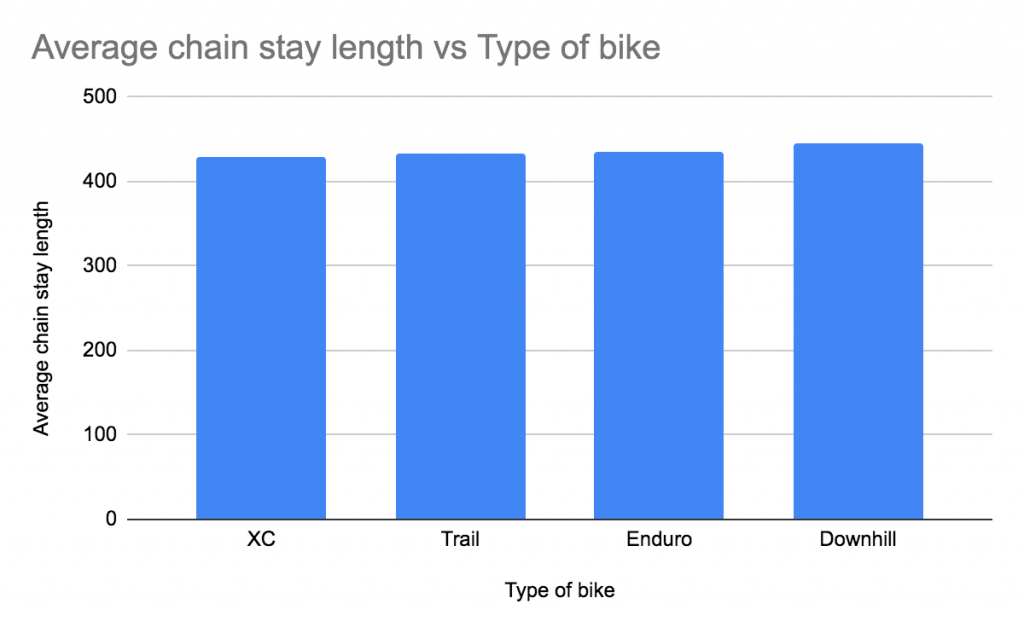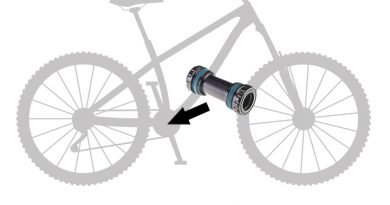What is a Chainstay on a Bike? (Explained)
This article gives you the ultimate insight into chainstays on a bike. We look at what chainstays do, and how different chainstay lengths affect the way your bike rides.
- What is a Chainstay on a Bike?
- Where Is The Chainstay On A Bike?
- Why Are The Two Chainstay Tubes Not Made Equally?
- Does Chainstay Length Change with Frame Size?
- What is Chainstay Length?
- What Is The Average Mountain Bike Chainstay Length?
- What Does A Longer Chainstay Do?
- What Does A Shorter Chainstay Do?
- How Does Chainstay Length Affect the way a Bike Handles?
- Do I need a Chainstay Protector?
- What Size Chainstay Protector Do I Need?
What is a Chainstay on a Bike?
The chainstay is a pair of metal tubes on the bike frame that connects the bottom bracket to the rear axle holders. The chainstay connects the bottom bracket to the centre of the back wheel.
Where Is The Chainstay On A Bike?
The chainstay sits between the bottom bracket shell and the rear dropout. It is the part of the frame which runs parallel to the top of the chain. The chainstay on the opposite side of the bike to the chain is also called a chainstay, despite the fact that the chain is not on that side of the bike.
Why Are The Two Chainstay Tubes Not Made Equally?
The chainstay on the drivetrain side is heavier to provide extra strength where the bike could be damaged. The chainstay on the other side is made lighter to improve efficiency.
Does Chainstay Length Change with Frame Size?
Usually not. The majority of bicycle frame manufacturers keep chainstay lengths the same. However, some brands are starting to realize the performance benefits of different chainstay lengths. So, it’s starting to become much more common to find various chainstay lengths depending on the frame size, or some brands offer inserts that allow chainstay lengths to be adjusted. Historically, bicycle frame manufacturers kept the chainstay length the same size as it helped to keep manufacturing costs down.
What is Chainstay Length?
Chainstay length is the distance from the centre of the rear axle of the bike to the centre of the bottom bracket.
What Is The Average Mountain Bike Chainstay Length?
We took a look at the latest bikes and took an average of their chainstay lengths by the type of mountain bike.
| Type of bike | Average chainstay length |
| XC | 430mm |
| Trail | 433mm |
| Enduro | 435mm |
| Downhill | 445mm |


What Does A Longer Chainstay Do?
Longer chainstays increase the wheelbase of the bike, with a number of effects.
- More stability: A longer chainstay and longer wheelbase help to make the bike more stable at high speeds.
- A less bumpy ride: Because the rider is closer to the centre of the bicycle, the ride feels less bumpy.
- Customization: A longer chainstay provides more room for fenders, thicker tires, and racks for the bike.
- Less manoeuvrability: It’s not all good news with a longer chainstay. A bike with a longer wheelbase will also be less maneuverable as a result.
- Not as good for tricks: A longer chainstay means the bike will not be as easy to hop about on or throw around.
- Heavier Frame: This isn’t a huge amount, but for those obsessed with getting their bikes as light as possible, it’s worth noting that the longer bike, as well as the longer chain, means extra weight to the bike.
- Not as good on obstacles: If you need to lift the front wheel to get over features, you will find it more difficult on a bike with a longer chainstay. Meaning it is not as good at tackling this sort of terrain.
What Does A Shorter Chainstay Do?
A shorter chainstay means that the bike will have a smaller wheelbase. This has a number of advantages, as well as some disadvantages:
- Better agility: A bike with shorter chainstays will be better at throwing around corners and moving around the trails.
- Better traction: Shorter chainstays mean that the rear wheel’s contact patch will be closer to your center of gravity, thereby increasing traction.
- Better acceleration: A shorter chainstay means that the drivetrain will be marginally stiffer, which provides slightly better acceleration and better climbing. This is only a tiny advantage, however, so it should not be considered a major selling point.
- Lighter: If weight is important, then this is worth considering – less material means a lighter bike.
- Worse handling: Once again, it’s not all good news. A more agile bike can end up handling badly unless the rest of the bike’s geometry is set up just right.
- Less stability: By having the rider’s center of gravity further back on the bike, riders sacrifice some stability at the front of the bike. This can be noticeable when trying to climb, on when trying to get front wheel grip in slippery turns.
- Compatibility: A shorter chainstay may mean that there is slightly less choice of components. However, this is rarely an issue.
How Does Chainstay Length Affect the way a Bike Handles?
So does chainstay length affect how a bike rides? Yes. A bike with a longer chainstay will be more stable, particularly at higher speeds, but will not be as agile. A bike with a shorter chainstay will be more agile but potentially less stable.
Do I need a Chainstay Protector?
You do not necessarily need a chainstay protector, but it is advisable in order to avoid damaging the chainstay. Also to keep the paint on your bike looking good, and to avoid your bike sounding like a bag of spanners on the downhills.
- On all bikes, there will be some degree of chainslap. Chain slap is when the chain hits or “slaps” the frame of the bike. The point of contact will inevitably be the chainstay, as it is the part of the frame closest to the chain. Chain slap can occur on road bikes, but due to the nature of the terrain that mountain bikes are ridden on – bumpy and uneven – chain slap is a far greater issue. Chain slap can also cause paint to chip, which takes away from the bike’s aesthetics as well as reduces the resale value.
- Chains can also throw mud and grease at the bike frame. These can take a great deal of effort to remove. A chainstay protector helps prevent it from getting on the frame, and if they are removable, then it can simply be disposed of to get rid of the dirt and grime.
- Chainstay protectors can come in many different styles. Quite a lot of new bikes come with a clear electrical protector already attached so that the appearance of the bike is not affected too much. However, some of these can be quite thin, and if you drop the chain, it can rip right through them, thereby not being particularly useful, so ensure that you find one that is suitably thick.
- Thick fabric covers are also available. However, whilst these offer excellent protection, they do get very dirty very quickly. This can be fixed, to some extent, by washing them, but if the appearance of your bike is particularly important to you, then it’s a good idea to have a spare for when your other one is in the wash.
- Neoprene covers that have velcro on for easy removal are fairly easy to clean and are a good way to protect your bike. Taking it off regularly also allows you to remove any dirt that has accumulated underneath as well as check the frame for any damage.
- Chainstay length is not universal, so it’s important to ensure that you get a protector that fits your bike. Even when you have one that fits the bike, it’s still a good idea to use zip ties to ensure that it stays securely attached to the frame. This will help prevent any dirt from getting underneath.
- It is also possible to make your own chainstay protector. Buying them is reasonably cheap, but if you happen to have some bar tape, old inner tubes, or even tape from a tennis racket/hockey stick handle lying around, then it is possible to upcycle them into a perfectly functional chainstay protector. It’s really down to your own imagination to see what you have lying around that can be used as a chainstay protector!
Here’s a cool video on how to make a chainstay protector
What Size Chainstay Protector Do I Need?
Measuring the length of the chainstay will tell you what size chainstay protector you need for your bike. Bikes come in all sorts of shapes and sizes, and this is as true of the chainstay as it is of any other part of the bike. Therefore it is important to measure your chainstay to ensure that you get a protector that fits properly.
Measure your chainstay 15mm away from the teeth of your front chainring and 15mm above the bottom jockey wheel on your rear derailleur. To measure the circumference of the chainstay, wrap a piece of paper around it and then measure the paper.
Most chainstay protectors come in 250mm lengths, These are easy enough to cut down to fit to a shorter chainstay, and extra pieces can be added for longer chainstays. Some protectors come with extra pieces to cover up longer chainstays.
You may also find interesting:




